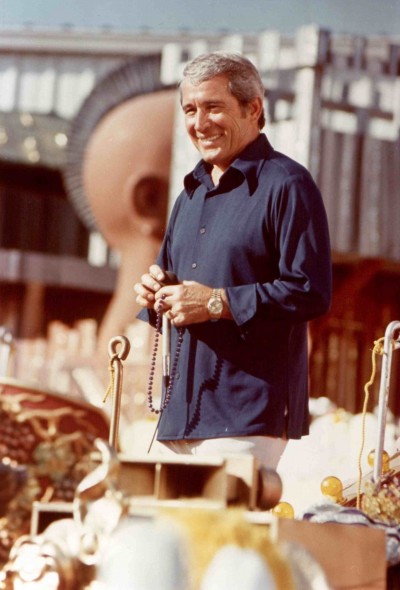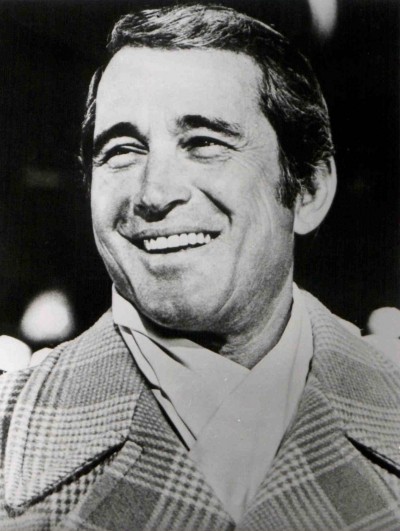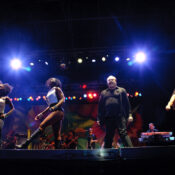When I was in sixth grade, I bought a vintage Perry Como publicity photo on eBay, found his address on one of those internet celebrity stalker sites, and mailed it to him with a long and possibly even coherent letter explaining why I, a 12-year-old born in 1988, was the biggest Perry Como fan in the world.
Como died a few months later at the age of 88 on May 12th, 2001—and a few days later, I received the photo back with his signature on it. So I probably have the last autograph of Perry Como’s life—not that anyone cares. I recently bought a signed Perry Como record contract for $48 on eBay, and the people who know me know to buy me Perry Como stuff for my birthday: both because I love him and because it’s a really, really affordable gift.
2012 marks the hundredth anniversary of Como’s birth, and I would bet anything that this piece might be the only mention of it in the media. But it’s high time for a re-examination of his legacy—and a rediscovery of one of the greatest and certainly the most underrated male singers of the Great American Songbook.
Indeed it was Perry Como’s success with the Ted Weems Orchestra that played a key role in inspiring Frank Sinatra to leave the Tommy Dorsey orchestra in 1942 and embark on a solo career. “Mr. Como was with Ted Weems, a then-popular orchestra leader, and he is still such a wonderful singer,” Sinatra said. “I thought if I don’t make a move out of this band and try to do it on my own soon, one of these guys will do it, and I’ll have to fight.”
If Frank Sinatra, a man known for many things—the ease with which he was intimidated not among them, felt threatened by the prospect of a Perry Como solo career, it’s worth a second look at his work.
That is where problems begin: the greatest enemy of Como’s legacy has been, paradoxically, his greatest successes. His biggest hits mainly consisted of faddish novelty songs: “Hot Diggity Dog (Ziggity Boom),” “Papa Loves Mambo,” “Hoop-De-Doo,” and “Kewpie Doll,” and melodramatic septuagenarian pabulum ballads like “Temptation,” “Prisoner of Love,” and “If,” and his improbable 1971 comeback “It’s Impossible.”
It’s tempting to blame Como for his willingness to sing poor material, but the truth is that nearly every popular vocalist of the era did the same thing. No one talks about “Mama Will Bark”—a duet that featured Sinatra singing with Dagmar and the sound effects of a dog—because it flopped and most disc jockeys played the B-side, “I’m a Fool to Want You,” instead. But the public responded best to Como’s worst songs, and his legacy has suffered for it.
But even on his worst songs—and especially on his better album cuts, the artistry and genius of the Perry Como style is evident. It is so smooth, not in the slick, self-conscious way that Dean Martin sang but in the understated, too confident to show off manner of a true pro. Como is the dancer who is so talented and practiced that it looks effortless, while lesser performers grunt, sweat and wail their way through shows.
But one of the best parts of the Perry Como experience is that you can listen knowing that he lived his life with the same mellow warmth of his music.
He was married to one woman, Roselle Como until her death in 1998. They were together for 65 years and adopted several children together. Como did no club appearances for 26 years—the prime of his career. Instead, he focused on his TV show, recordings, and family. A 1957 Look magazine cover story asked the question: “Perry Como: Is He Really Mr. Nice Guy?”
“It is pointed out that Como is the only TV performer with a price tag of more than a million dollars a year who has no enemies and no embarrassing eccentricities and whose personal life has always been unblemished by gossip,” reporter Joe McCarthy noted.
“I’m not relaxed, I’m just tired,” Como told him.

Como was one of 13 children born to Italian immigrants in Cannonsburg, Pennsylvania. His father worked as a laborer at a tin-plate factory for $35 per week. By the time Perry was 10 years old, he was getting up at 6:00 each day to sweep the floor at a barber shop on his way to school; after class, he returned to shine shoes, heat towels, and sharpen razors. He had his own chair as a barber by the age of 13, and was a major contributor to his family’s finances.
He left the hair business to embark on a singing career. When not making progress, he returned to the barbershop for several years before he was lured back into show business with the offer of his own radio show. When a reporter suspected that the “singing barber” story was an invention of a record-company marketing department, Como responded by giving the reporter a free haircut.
In the 1950s, Como hit his stride as one of the most popular television show hosts of his era. The Perry Como Show ran in various incarnations into the 1960s, while he continued to record occasional specials.
It was during The Perry Como Show period that he recorded a series of albums for RCA/Victor. With the TV show providing Como with a built-in audience and rock and roll bumping the traditional pop vocalists off the radio, there was less pressure to focus on hit singles, and the best-recorded work of Perry Como’s career emerged.
While Sinatra was recording the concept albums that marked the rebirth of his career, Como was scoring steady sellers with titles such as So Smooth, We Get Letters (1957), Saturday Night With Mr. C (1958), Como Swings (1959), and 1961’s Young at Heart. Como’s albums provide the laidback counterpart to Sinatra’s hip Las Vegas sound.
If I could pick one song that epitomizes the Perry Como style at its best, it would be “Gypsy in My Soul,” the eighth track on Saturday Night with Mr. C. With light orchestration, Como just rolls through the song: “If I am fancy-free and love to wander, it’s just a gypsy in my soul,” he sings, letting the last word drift off into two syllables. The enunciation is understated and lilting, and the result is a song that is almost impossible to listen to without smiling.
The almost completely forgotten ballad “Toselli’s Serenade” is another of Como’s best recordings, this one from 1966. It’s a sad song (Dreams and memories/Are all that you’ve left me/Only lonely thoughts/About the one I worship and adore) out dreams and regrets is the perfect treatment for it. Mario Lanza, generally regarded as a superior vocalist, belts it into a dramatic power ballad. But Como’s version is both more enjoyable and more in sync with the lyrics.
In a business where leaving a distinct mark on each song is seen as a key to success, Como’s understated, unselfconscious performances set him apart. Ironically, it may explain why he’s forgotten; his style has been supplanted by belters. “Once you know a song too well, you start to fool around with it.” he said. “At the session, when the band’s working on the arrangement, I learn the tune right there.”
Como’s onscreen presence matched his vocals. Though his movie career at MGM was unsuccessful (his most well-known film being 1945’s Doll Face with co-stars Vivian Blaine and Carmen Miranda), his laidback manner could not have been better suited to the early days of television. With a sound and presence inoffensive and warm, Como was exactly what people wanted in their living rooms.
A 1954 12-city poll of 20-year-old women by Life magazine found that Perry Como was the most popular choice for a potential spouse even though the magazine noted, he “does not fit all the requirements nor all of the personal characteristics girls rate high. He is 5 feet 9 1/2 inches tall instead of 6 feet. His eyes are brown instead of blue and he is not 23. He almost never washes dishes.”
“I was always relaxed on camera when I sang, mainly because I’m not very high-strung or animated by nature.” he told Good Housekeeping in a 1990 profile. “Acting coaches in Hollywood were always telling me to use my hands and body more. But that was never me. I just breathe and sometimes it doesn’t look as if I’m doing that.”
One of the more interesting The Perry Como Show clips available on YouTube is a 1961 duet with 13-year-old Brenda Lee, who had recently had a major hit with “I’m Sorry.” In the video, they sing a medley including “Teach Me Tonight” and “An Apple for the Teacher”—a hit for Bing Crosby, who was Como’s biggest influence along with the long forgotten Russ Columbo. Ms. Lee appears nervous and flubs several lyrics. Como then flubs one, too, something he was not known for doing and this was, perhaps, an effort to put her at ease. Como’s posture is slightly stooped, and his manner is paternal.
When he died, RCA Records took out a full-page ad in Billboard that said simply this: “50 years of music and a life well lived. An example to all.”
Ultimately, Como’s unpretentious, warm, and light style was replaced, in some cases literally, by a more self-conscious, egocentric style of music and life: the building where he spent parts of two decades recording The Perry Como Show became Studio 54 and to the extent that he still gets any airplay at all, it comes during the holidays.
His recording of “Home for the Holidays” is still one of the more popular Christmas songs, although the less remarkable Andy Williams seems to be the crooner of choice for radio these days; Williams and Elvis Presley were the only artists to have two of the 25 Christmas songs with the most radio play in 2010, according to data from the monitoring service Mediaguide.
But Como likely wouldn’t care. An unabashed popular entertainer, he greeted his declining popularity the same way he greeted his rise to success. “I’ve done nothing that I can call exciting,” Como once said. “I was a barber. Since then I’ve been a singer. That’s it.”
On the 100th anniversary of Como’s birth, with the Great American Songbook enjoying a comeback thanks to singers like Michael Bublé and Rod Stewart, it’s time for fans of classic pop to give the best and nicest singer of the era another listen.
Zac Bissonnette is the author of Debt-Free U. He’s been featured on The Today Show, CNN, Fox News, and NPR. He writes for Time.com and is a contributing editor with The Antique Trader.
Become a Saturday Evening Post member and enjoy unlimited access. Subscribe now




Comments
I think a good part of the reason why Perry Como’s popularity didn’t continue like it should have is because like a lot of music, they just quit playing them. I always liked his music but I didn’t realize how many wonderful songs he sang that I had never heard until I downloaded a few different music apps off the Internet the last few years. Some were remakes of songs I’d heard other artists sing but never overly cared for to much, that is until I heard Perry Como‘s version, all I can say is, wow. And his songs I had heard through the years were not one of of them. I’m sure that the vast majority of people never heard them either until the Internet came along and they found out the same way I did, and he was still that famously popular all those years from songs that were for the most part not even close to the wonderful music he sang that few ever heard until recently because of the Internet.
Was revisiting my Como collection when I came across your much appreciated article. I must confess that, while I cringe at Sinatra and Bennett’s few attempts at reaching the teen market in the 50’s, Perry Como’s efforts retain their sense of happiness and charm for me. Sinatra & Bennett needed good material, while Como and Nat Cole were able to turn dross into gold. Happy to see you made mention of “Toselli’s Serenade”. I’ve just discovered the mid-60’s Italian album and find it to be one of his best. What’s good remains. Thanks again for your insights.
A comment was made in the article that ‘Mario Lanza ‘is considered a ‘better singer’ on what basi'”Como was a light baratone ,Lanza a tenor .They both recorded ballads ,such as Because, Song of Songs ,Temptation,Bless this House,and a number of other ballads ,and ballads were perhaps the real key to Perry,s amazing voice ‘He could hit the high notes with a full volume that no other crooner ever achieved,He certainly matched Mario , for not ducking the high notes ,I love listening to both of these great artists. ,They only come along once in a lifetime,and Iv been around a long time ‘
Thank you so much for this wonderful article. I wholeheartedly agree that Mr. Como is very underrated. He was a true artist and a great man that will live on forever with his records. I, too became a Como fan at 12 and now I’m 16. I admire Mr. Como a lot, even to the point of having a frames photo of him at my home. Good day.
Sorry. The web address of the article should have been:
http://shickshinny.wordpress.com/2012/05/11/shickshinny-mocanaqua-and-nanticoke-and-wnak-730-on-your-am-dial/
Or just click on my name (Glen) and it’ll link to my article.
Glen Slater
Zac, EXCELLENT article. I really enjoyed it. I’ve got to give you credit for having the guts to not conform to peer pressure. I assume that very few people of your age like Perry Como, although some might listen to him when no one else is around! Who knows? But even fewer people of your age would admit to being a Perry Como fan, as you have! I admire you both for your writing ability and your nonconformity.
Those who liked Zac’s article, as I did, would also enjoy the article that I wrote on my blog. My article is at /2012/05/11/shickshinny-mocanaqua-and-nanticoke-and-wnak-730-on-your-am-dial/
Glen Slater
Thank you, Zac Bassonnette, for writing this article. My mother’s favorite record was a 78 of Perry Como singing “Ave Maria”. When I would go to visit her in her last few years, I would play a couple of cassettes of Perry Como singing. I kept the cassettes after she died.
I grew up in the era of the crooners. Perry was among my favorites. I still have my Saturday Night with Mr. C. album. Bing Crosby was the giant of the class but I considered Perry and Frank Sinatra in the same class. Como’s novelty songs are not among my favorites but the ones you consider melodramatic I consider among his best. He did a duet with the late Eddie Fisher of the old Ink Spots song “Maybe” in which his crooner style and Fisher’s “belter” style harmonize beautifully.
I was quite surprised when I saw this piece on Perry Como.I too remember him on T.V.and his smooth mellow voice.Most of all I remember him sitting on his stool while singing and he looked so relaxed you felt as if he were about to fall asleep.I may be a little older than Mr.Bissonnette but he hit the nail right on the head,about Perry Como.I learned some interesting facts about Mr.Como, and appreciate Mr.Bissonnette shareing that with us.
Also a Fan of Perry Como
Tony Bush